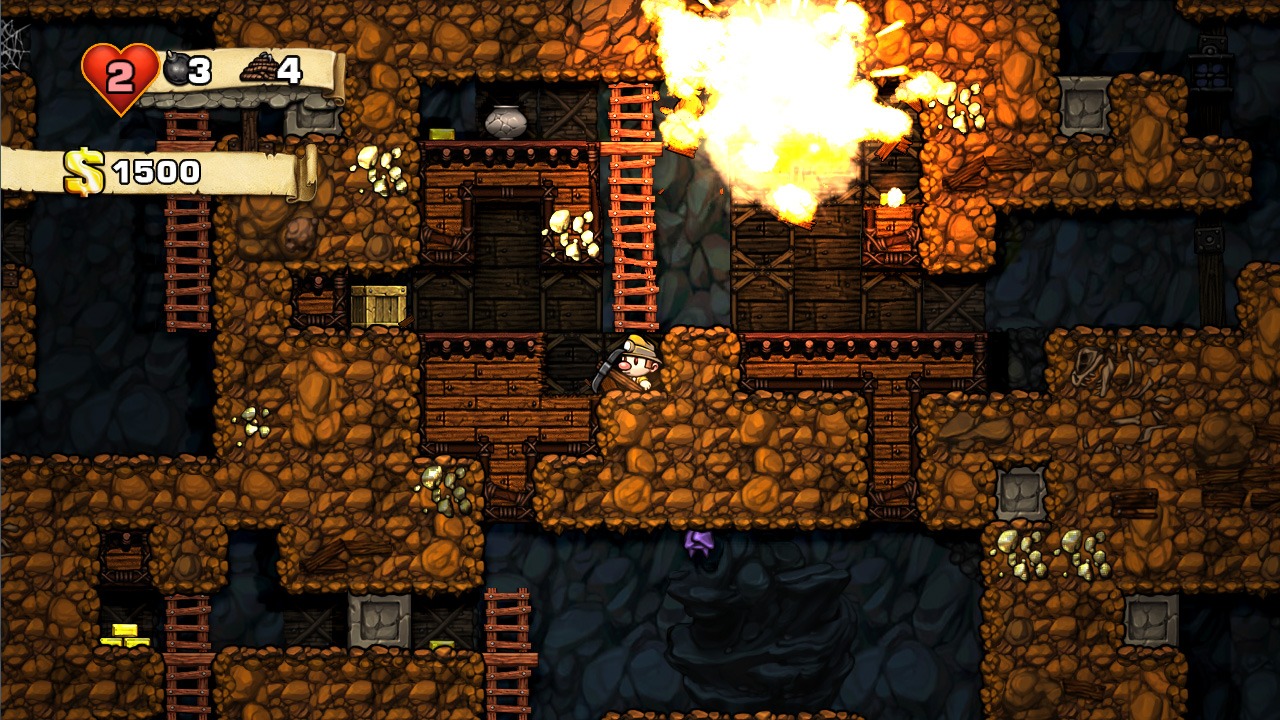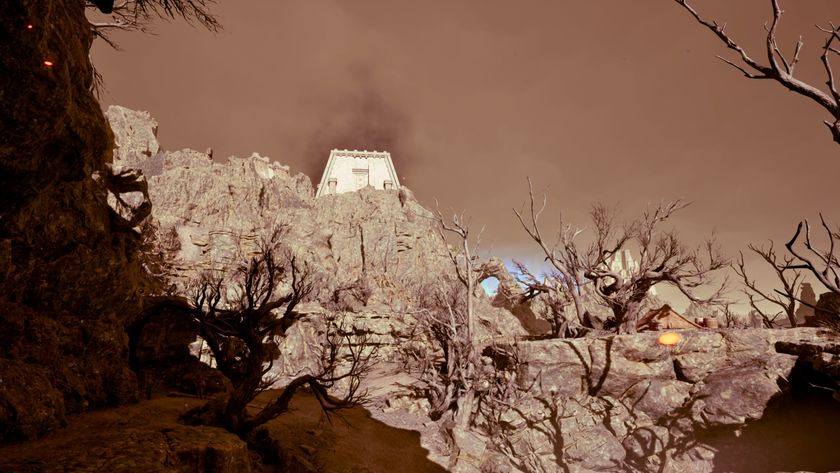Our Verdict
Straightforward and replayable, Spelunky is precision engineered to make death fair, funny, and a story worth sharing.
PC Gamer's got your back
Expect to pay: £12 / $15
Release: out now
Developer: mossmouth
Publisher: In-house
Multiplayer: 4-player deathmatch or co-op
Link: Official site
I should have been more careful. Having reached the end of one of Spelunky's procedurally generated levels, I turned my back on the exit, and decided to bomb my way inside a snake pit instead.
Snake pits are one of the game's most exciting random elements, as they're level-deep and filled with, yes, snakes, but also precious jewels, mysterious crates and, buried in the rock at the bottom, a mattock. The latter is always too good an opportunity to pass up; with the mattock in my hand, I can mine my way through the destructible blocks that form Spelunky's world, avoiding traps and gathering gold in my rush towards Olmec, the game's boss.
I placed a bomb at the bottom corner of the pit's outer wall. It exploded. The explosion propelled a rock towards me. The rock hit me in the face. I tumbled backwards, stunned, and died on some spikes.
When the free version of Spelunky was released in 2009, it was one of the first indie games to take the tenets of roguelikes – random level generation, extreme difficulty, permadeath – and dust off the genre to make it accessible. It does that not by being any more forgiving than its inspirations, but by combining those elements with the controls and cuteness of a 2D platformer.
In the four years since, Spelunky has become the background radiation of my gaming life. Whenever I need to think, or need a break from something else I'm playing, I'll boot it up for 20 minutes. Every time, I encounter something new. Every time, my death is brutal. And every single time, I ask questions: what did I do wrong? Was my death fair? What should I have done differently?
I think my ability to find satisfactory answers to all three of those questions is why I keep coming back to Spelunky. I always know what I did wrong. The death is always fair. I should have been more careful.

A lot has been written about Spelunky's procedural level generation – the ability of the game to construct the varied and challenging terrain of your adventures, and which prevents them from becoming repetitive or frustrating through endless new lives. It is impressive, and the game wouldn't be as great without it. But it's the parts that remain the same that enable me to answer the questions above.
Your descent into Spelunky's underground complex is divided into worlds, each with its own menagerie of creatures, its own traps and special items. The mines are home to snakes, spiders, bats, dart traps and a magical Udjet Eye that lets you see gems in the rock. The jungle has exploding frogs, pools of chomping fish, people-eating plants, and a door buried in rock that leads to a black market full of shopkeepers selling the game's most valuable items. An ice world and an Aztec world follow, with their own population of aliens, angry yetis and psychic staffwielding Anubis guards.
The order and quantity of these enemies changes, and you'll find yourself constantly surprised and challenged by randomly deployed special levels, such as the mine where the ceilings are covered in giant spiders, or the ice level where the centrepiece is a tall alien spaceship with a tempting door at the top. There are mysteries out there I still haven't discovered.
The excitement of exploring a fresh new world each time is paired with the satisfaction of learning a set of rules which are applicable on every level. You always begin with four bombs and four ropes in your pocket, and I know how much gold or gems need to be in an area to make it worth using one of these to get there. I know that I should always whip jars twice to burst them, in case they contain an enemy.
After the hundreds of hours I've played Spelunky, I've internalised all these universal systems to such an extent that I can close my eyes and continue playing even when away from the computer. The game is so precise and logical that I can build a challenge – plop down three tiki traps, position a bat, a spike pit, and a frog – and then set the game in motion. I can trace the slope of the bat down towards my character, the arc of the frog's leap.
This is how you tackle every challenge in the game: look at it, play it out inside your head, then try to carry out your plan. Slowly and surely, Spelunky turns its players into Spelunky simulators, and challenges them to resolve that gap between imagination and execution.

That's a hard challenge to overcome. I've filled a mental wiki with Spelunky tidbits, but I still occasionally make a mistake and die on world one, level one. Spelunky keeps me from being bored due to its level generation; it keeps me from being frustrated by always acting as I expect that it should; and the endless opportunity to screw up has thus far kept me entertained through over five thousand deaths.
That gives me thousands of examples of these systems at work. On a recent run, I reached the ice world. Where the mines and jungle levels are defined by tight spaces, the ice world is open, with slippy platforms floating in an abyss. Luckily I had the cape, which allows you to press jump in mid-air to float and gently steer yourself towards your desired landing site.
As I drifted towards the exit on one level, I failed to notice a rock sitting on top of a jump pad.
The jump pad hurled the rock into the air, where it stunned me, and knocked me onto the ledge just above the pad. The rock fell back onto the pad, and before I was able to move it was again launched against my head. And then again, and again, until I was dead, defeated for the second time by a supposedly inanimate object.
Spelunky places you in ridiculous and terrifying situations with far more regularity than is reasonable for a game with procedurally generated levels. Whether I'm angering a shopkeeper in the same second as I enter a door into a black market full of them, or parachuting into the abyss, or being trapped alongside my own bomb in the worm level, I'm simultaneously laughing, groaning and drafting a message to a friend to talk about it.
This latest version – a PC port of Spelunky HD, the from-scratch rebuild of the free PC original – adds an extra feature to the Steam edition that makes all of the game's systems seem even more compelling: Daily Challenges. Each day a version of the world is generated that is the same for everyone, and which can be played only once.

This has spawned a community around the game that never existed before. I spend a portion of every day, after I've run my own Daily, watching YouTube videos of how my friends tackled, overcame and eventually died against the same combination of challenges. It's pleasing to know you did better, heartbreaking to know you did worse, and gut-wrenching to know the gift-wrapped mystery box you decided not to risk buying on the second level contained the jetpack, the game's best item.
These videos are an extension of the anecdotes that Spelunky players have been sharing with one another since the first version of the game: anecdotes that centre on the player's death – The Failure with a Thousand Faces – but they've never been more exciting.
Spelunky represents half a dozen game design philosophies that I wish more games would copy. It isn't easy, but it is accessible. It's not scripted, but you tell stories through it. It's challenging, but those challenges are always fair. Its procedural generation makes it replayable. Its Daily Challenges and local co-op mode make it an experience you can share, and I've played the latter for dozens of hours all on its own. Even the PC port, after an early patch, gives you all the options you'd want in terms of resolution and windowed modes.
I could go further, and wax lyrical about how that bat descent angle is carefully calibrated to mess with you; about how the level generation still hasn't had enough good things said about it, and about how the game crafts scenarios that tempt you into taking risks; about the poignant deaths of its idiot AI slaves; about how cute the rescuable pug is.
Spelunky's moving parts are simple – the free version was built using the entry-level game development tool, Game Maker – but they click together in ways smart enough that they've kept me joyfully exploring its depths for years, without ever reaching the bottom. You don't need to be careful about this. Just buy it.
Straightforward and replayable, Spelunky is precision engineered to make death fair, funny, and a story worth sharing.




